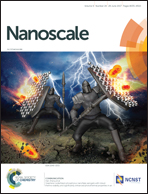High performance bi-layer atomic switching devices†
Abstract
Atomic switches, also known as conductive bridging random access memory devices, are resistive-switching devices that utilize the electrochemical reactions within a solid electrolyte between metal electrodes, and are considered essential components of future information storage and logic building blocks. In spite of their advantages as next generation switching components such as high density, large scalability, and low power consumption, the large deviations in their electrical properties and the instability of their switching behaviors hinder their application in information processing systems. Here, we report the fabrication of a uniform, low-power atomic switch with a bi-layer structure consisting of Ta2O5−x as the main switching layer (SL) and a relatively oxygen-deficient TaOx as an oxygen vacancy control layer (VCL). The depth profiles of the filaments in the bi-layer device were obtained by performing conductive atomic force microscopy to assess the improvements in uniformity, reliability, and electrical performance that result from the insertion of the VCL. The coefficient of variation of the high resistance state of the bi-layer device was found to be drastically reduced from 60.92% to 2.77% in the cycle-to-cycle measurements and from 82.73% to 4.85% in the device-to-device measurements when compared with the values obtained for a single-layer device. The bi-layer device also exhibits a forming-free low operation voltage of ∼0.4 V, a high on/off ratio of ∼106, and high reliability with 10 years data retention at 85 °C.



 Please wait while we load your content...
Please wait while we load your content...